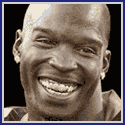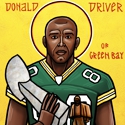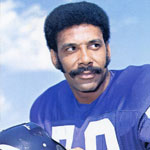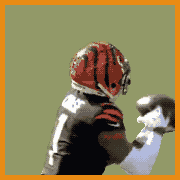|
Football 101 Post info here for stupid newbies like me to read and learn Required Readings:- http://en.wikipedia.org/wiki/National_Football_League http://en.wikipedia.org/wiki/American_football http://en.wikipedia.org/wiki/Nfl_lore http://en.wikipedia.org/wiki/Signif...ries_in_the_NFL http://smartfootball.com/ Books for nerds McKracken posted:Besides Football Scouting Methods, I would recommend some of the Coach of the Year Clinics, and books specifically aimed at coaches if you think your knowledge is up to par to understand the terminology. McKracken posted:There are a few books I've got queued up but haven't had time to read yet. Maybe we can add a recommended reading list to the OP at some point. Strange Matter posted:I enjoyed Jaworski's "The Games that Changed the Game," though some of the games he chooses seem kinda wonky. It is very rewarding to read about how Buddy Ryan's Bears dismantled the Cowboys though. Ozu posted:1. I asked the same questions a few weeks back and came back with recommendations for "Football Scouting Methods" by Steve Belichick (Bill's father) and "Finding the Winning Edge" by Brian Billick and Bill Walsh, which is out of print. Just started on the Belichick one and it's pretty fantastic so far. jeffersonlives posted:Yeah, this is what I wrote the last time it came up: Useful Threads The rules thread http://forums.somethingawful.com/showthread.php?threadid=3431516 Football Injuries Thread http://forums.somethingawful.com/showthread.php?threadid=3441579 Awesome detailed breakdown of things jeffersonlives posted:OFFENSIVE FOOTBALL WombBroom posted:I am working on an edit for this post that will answer your questions, but it will take a bit of time to get them fully fleshed out, as I want to add in some reference spots for you. In the meantime, I will give you some cursory information that should whet your whistle while I go more in depth. Gendo posted:Sure. I'll give you a rough overview of a simple box score to start out with, then if you have more questions we can go from there. tk posted:I'm going to expand on this. Not all of this directly pertains directly to football, but it comes up a lot and can be useful to know. adaz posted:This will probably cause Notre Dame fans to froth at the mouths (so a win-win) but Bob Davie wrote an excellent series of columns for ESPN.com years ago on various formations, schemes, blocking, basic football, etc breaking them down and how they work. It's insider only content but I'll post an example. With mod approval I can post more. adaz posted:As it turns out a few of these are NOT insider only and are really awesome sources of information. I've compiled some links for you all. nnnAdam posted:
WombBroom posted:This is an extremely complicated question to answer, but I will do my very best for you. No Safe Word posted:Just be ready for crushing depression when the Texans go 1-5 in their division again. korranus posted:A look at the bowl system and conferences of the Football Bowl Subdivision: Choosing a team Any suggestions on choosing a team for those that are new to the sport. Obviously its easy if you actually live in the US, but for us dirty foreigners we have free reign to choose whatever team For myself, I recently visited the old Cowboys stadium so that seems like a logical place to start for me. sc0tty fucked around with this message at 15:26 on Nov 2, 2011 |
|
|
|

|
| # ? Apr 19, 2024 05:03 |
|
sc0tty posted:2010 FBS Team Breakdown (I don't know what FBS is but this looks to be College football. I am smart) Football Bowl Subdivision, formerly known as Division 1, is the top level of college football, where the post season consists of a series of bowl games instead of a playoff. Most people, I believe, want to go to a playoff system, but there is so much money tied up in bowls that this may never happen.
|
|
|
|
sc0tty posted:
LA has gotten so many chances for a football team, but has run them all out. Still the Jaguars look like they might move there.
|
|
|
|
sc0tty posted:
After the regular season is over, the division champion (The top team from each of the four divisions per conference) advance to playoffs. In addition, two "wild card" teams from each conference advance as the fifth and sixth teams in the playoffs. These teams are the teams with the two best records in the conference that didn't win their divisions.
|
|
|
|
sc0tty posted:Q. Whats the deal with divisions and division grouping. The Cowboys with NY, Philly and Washington? The NFL realigned a decade or so back to 8 4 team divisions from 6 divisions of various sizes. It is far more geographically sane that it was but to keep some traditional rivalries intact (like the cowboys/redskins) some teams are a bit "odd" in where they are located. quote:Q. In the wiki it mentions that there is no salary cap in 2010. This sounds like a pretty big deal. Is this true? It's true, but it hasn't been a big deal so far. The biggest impact has been teams cutting players who they otherwise wouldn't have been able to. a lot more trades than you would've seen happen in a capped year, and quite a few contract extensions that are heavily front loaded to take advantage of the no cap year.
|
|
|
|
quote:Q. Seems surprising that there is no Los Angeles team. What's up with that? They had the Rams in the mid-90's but they're more useful as a scapegoat to extort funds for stadium upgrades from other cities than as a team hosting city. The NFL is so insanely popular right now that while it'd be a nice market to have a team in, it's not at the top of anyone's priorities to move to. The Jaguars are the most likely to move there in a few years though. quote:Q. Whats the deal with divisions and division grouping. The Cowboys with NY, Philly and Washington? Historical rivalries is the answer to the slightly odd placement. The divisions were re-aligned in 2002, from a 3 division per conference format (East, Central, West) to a 4 division format. As there were some very, very odd situations back then like ARIZONA being in the NFC East, TAMPA BAY being in the NFC Central and ATLANTA being in the NFC West. However, the Cowboys have hue ongoing rivalries with the other 3 teams in the East, so they stayed. There's a few others like that, like with Miami being in the AFC East instead of say, Baltimore or what will happen if the Jaguars actually do go to LA eventually. quote:Q. In the wiki it mentions that there is no salary cap in 2010. This sounds like a pretty big deal. Is this true? Yes and No. Yes in that going forward, if there's no salary cap, and no salary floor, a baseball like situation might develop where payroll levels are drastically apart. However, there are numerous things keeping it in check this year. The salary floor was quite possibly more important then the cap the last few years, as teams have to spend near 90% of the salary cap. Basically, the salary cap is set at a certain percentage of league revenues. The last collective bargaining agreement raised this really high, and combined with the last round of television deals, saw the salary cap skyrocket. There were also rules put in place that the teams that made the divisional round were somewhat restricted in signing free agents this offseason, but that really didn't seem to impact much. When the salary cap was put in originally (back in 1993), it was $34.5 million per team. It increased at a somewhat level pace until 2005 where it was $85.5 million. Then the CBA was re-negotiated and it jumped to $102 million for 2006 all the way to $128 million for 2009. The salary cap was increasing so fast, that, combined with the uh... "inventive" accounting methods teams use when writing player contracts, the salary cap had mostly ceased to be an issue.
|
|
|
|
sc0tty posted:Q. Could somebody explain the statistics and 'boxscore' formats that are typically used to cover NFL games. Coming from the NBA these things can be a little confusing. This is a pretty typical NFL box score. Let's go over it piece by piece. First there's the scoring summaries and stat summaries:  Scoring Summary The scoring summary is pretty self-explanatory. Scoring drives are listed in the order they occurred by quarter. The icon indicates which team scored. The time is at what time in that quarter the score happened. The next column is the scoring play and the result of either the extra point or two point conversion (if applicable) and the score after the drive is listed next to that. The team stat comparison is a little more complicated. Team Stats 1. First downs is the total number of first downs for each team, which is then broken down into the numbers of first downs each team earned as a result of passing, rushing or as the result of a penalty. 2. Third down efficiency is a measure of how many times each team converted a third down to a first down. 3. Fourth down efficiency is the same as above but for fourth downs. 4. Passing lists the total passing yards for each team. 5. Comp-Att is a measure of how many passes each team completed versus how many attempts, in this example the Vikings completed 28 passes out of 33 attempts. 6. Yards Per Pass is exactly what it says. The number of total passing yards divided by pass attempts. 7. Rushing is the number of rushing yards each team earned. 8. Rushing attempts is the number of rushing plays each team ran. 9. Yards per rush is the number of yards gained divided by rushing attempts. 10. Turnovers is the number of times each team turned the ball over to the other team either as the result of a lost fumble, interception or loss of downs. 11. The above is then broken down into fumbles lost and interceptions thrown. 12. Defensive / Special Teams TDs is a measure of how many times each team scored a defensive TD (on an interception or fumble return) or a special teams TD (blocked kick returned for a TD, punt or kickoff return for a TD, etc). 13. Possession is a measure of the time of possession for each team. Basically how long each team's offense held onto the ball. Now to move onto the individual offensive stats:  Passing Stats 1. C/ATT is shorthand for the Completions/Attempts we discussed above. So in this example Favre threw the ball 25 times and completed 22 passes. That is 22 were caught. 2. YDS are the number of yards passing he had. 3. AVG is shorthand for yards per pass. So passing yards divided by passing attempts. 4. TD represents passing touchdowns. 5. INT represents interceptions thrown. 6. Rating stands for QB rating, a statistic that attempts to combine all QB passing statistics into one easy to digest number. If you're curious it's ((((Comp/Att) * 100) -30) / 20 + (((TDs/Att) * 100) / 5) + ((9.5 - ((Int/Att) * 100)) / 4) + (((Yards/Att) - 3) / 4)) / .06. Yes really. Rushing Stats 1. CAR stands for carries, the number of rushing attempts for each player. 2. YDS are the number of yards gained for each player on rushing attempts. 3. AVG are the average number of yards gained, so yards / carries. 4. TD represents rushing TDs for each player. 5. LG is the longest rush for each player. Receiving Stats 1. REC is the number of receptions for each player. So in this game Shiancoe has the most receptions with 8. 2. YDS are the number of receiving yards. 3. AVG are the average number of yards per catch, so yards / receptions. 4. LG, as above, represent the longest reception for each player. 5. TGTS are the number of times each player was targeted with a pass. FUMBLES This is kind of an in-between category as both offensive and defensive players get lumped here. You are listed here if you lose or recover a fumble. In this example we only see Heath Farwell who recovered a Seattle fumble for the Vikings but obviously these three categories are FUM (Fumbles), LOST (Fumbles Lost) and REC (Fumbles Recovered). Now for Defensive Statistics.  Defensive statistics are split into two categories here. Tackels and Misc. 1. TOT is total tackles. 2. SOLO is solo tackles, tackles made without assistance from another player. 3. SACKS are total sacks, the number of times an eligible passer was tackled behind the line of scrimmage. 4. TFL is tackles for a loss, the number of times a ball carrier was tackled behind the line of scrimmage. 5. PD is passes defensed, the number of times a defender tipped, deflected or otherwise interfered with a pass in the air intended for an offensive player. 6. QB Hits are the number of times the defensive player hit the QB but it did not result in a sack. 7. TD represents defensive touchdowns. Now let's finish with special teams.  Kick Returns 1. NO is the number of kick returns. 2. YDS is the number of yards gained on those kick returns. 3. AVG is the average number of yards per kick return (yards / no). 4. TD is the number of kick return touchdowns. Punt Returns Same as above but for punts. Kicking  1. FG The fraction lists the number of successful kicks over the number of attempts. (So if you made 2 but attempted 3 it would be 2/3). 2. The PCT is the percentage of kicks made. 3. LONG is the longest kick made. 4. XP (see Vikings example) is the same as the FG but for extra points, the number of successful extra points over attempted extra points. 5. PTS is the total number of points gained by kicks (FGs * 3 + XPs).
|
|
|
|
I am working on an edit for this post that will answer your questions, but it will take a bit of time to get them fully fleshed out, as I want to add in some reference spots for you. In the meantime, I will give you some cursory information that should whet your whistle while I go more in depth. Let me first get out of the way: The Cowboys are evil incarnate and if you become a Cowboy fan, you will rot in hell alongside Jamarcus Russel, and he won't give you any of his Skittles. On to your questions! quote:Q. Could somebody explain the statistics and 'boxscore' formats that are typically used to cover NFL games. Coming from the NBA these things can be a little confusing. While I'm not completely certain what you're asking, the main statistics that everyone cares about vary. this is because Offensive, Defensive, and Other statistics are all rated individually. For instance, no one cares if an Offensive player has any Sacks, and no one cares if a Defensive player has a high completion percentage. So, I will break it all down based upon position. Offense Quarterback The Quarterback is often referred to as "The most important position," or some variation thereof, on a football team. That is because, in most situations, the Quarterback is the first player to have possession of the football on Offense. The Center, the guy who plays in the middle of the Offensive line, hikes the ball to the Quarterback and the play begins. The stats that matter most for a Quarterback is his Passer rating. This rating is a mix of Completion Percentage, Passing Yardage, Touchdowns and Interceptions. In the NFL, a perfect passer rating is 158.3. More info here: http://en.wikipedia.org/wiki/Passer_rating Fullback The Fullback position is largely gone from football these days. In the past, the Fullback was mainly a blocker for the Halfback (which we'll get to next). There is no statistical measurement of blocking as it is a very difficult thing to keep track of. Halfback The Halfback or Runningback is the primary player when running the ball (imagine that!). Usually, the Quarterback hands the ball to the Halfback who tries his best to weave his way through defenders and gain positive yardage. The primary stats most people care about for a Runningback are Attempts, Total Yards, Average Yards, Touchdowns and Fumbles. A Runningback who gets more than 1,000 yards in a season is considered above average. Tight End The Tight End was traditionally seen as a big guy who could block pass rushers and lay blocks down on running plays. However, the past 15 years or so have seen a large number of receiving tight ends pop up in the league, so the position has changed somewhat. All tight ends will be asked to catch the ball at some point, but some (Dallas Clark from Indianapolis and Kellen Winslow from Tampa Bay) are extremely good at it. However, their size and athletic ability makes the more suited to Tight End than receiver. The stats that matter most to a TE are the same as the ones that matter to a Receiver: Catches, Yards Per Catch, Yards After The Catch, Touchdowns and Fumbles. Wide Receiver Some one will inevtiably tell you that not all receivers are Wide Receivers, because some are Flankers and some are Slot guys, or several other terms that aren't important for this discussion. Just understand that there are several places Receivers can line up which dictates the routes they will run through the defense. The stats that matter are Catches, Yards Per Catch, Yards After the Catch, Touchdowns and Fumbles. There have been numerous attempts over the years at recording the Drops each receiver has, but this is not an official stat. Offensive Line I'm grouping the line together because it makes more sense for this particular discussion. They are the big guys who get little notice and less money (on average) than most other players, but IMVHO, are the most important guys on the Offensive side of the ball. The stats that matter are: Sacks Allowed. That's really all that matters. Officially, the NFL website only shows the Games Played and Games Started stats for Offensive Lineman. Linkage: http://www.nfl.com/players/jefffaine/situationalstats?id=FAI112720 Defense Linebacker These are the guys who stand behind the Defensive Line and either cover the short to intermediate receiver routes, or try to tackle the runner on running plays. There are several different Linebacker positions, and each one will have a preference to one of the stats, depending on their main responsibility (runn-stuffing versus coverage) but all of them care about these stats: Tackles (solo and assisted), Sacks, Forced Fumbles and Interceptions. Defensive Backs There are several positions that fit under the guise of Defensive Back. Cornerbacks, Nicklebacks, Dimebacks, Strong Safety, and Free Safety are all considered to be Defensive Backs. Like Linebackers, each different DB will be measured differently upon each stat because of different responsibilities, but the main stats are: Passes Defensed, Tackles, Forced Fumbles and Interceptions. Defensive Line These are the big boys up front whose two main jobs are to sack the Quarterback and Tackle the ball carrier before plays can develop. Again, each one will be measured with differeing weight on each stat, but the ones that matter most are: Sacks (solo and Assisted), Tackles for a Loss, and Tackles (solo and assisted). I think I'm gonna need more than one post! Edit: wow, I totally thought he was asking something different. Crap.
|
|
|
|
Gendo posted:I don't like this post. I love this post. :Berman:
|
|
|
|
quote:
Okay, how the schedule works is slightly odd since the season is only 16 games long, but here's how it works. We'll use the Buffalo Bills as an example. 6 games - The play each other team in their division twice (the Jets, Patriots and Dolphins) 4 games - They play all 4 teams in one of the 3 other divisions in their conference. For 2010, it's the AFC North, and rotates every year (in 2009 they played the AFC South and 2008 was the AFC West's turn). 4 games - They play all 4 teams in one of the 4 divisions in the opposing conference. For this year it's the NFC North. Last year was the NFC South, and in 2008 the NFC West. 2 games - These are the strength of schedule balancing games. They play the two teams in divisions in their conference that finished in the same spot they did (dead last), that aren't in the AFC North, since they're already playing that team. So this year, the Bills will be playing fellow basement dwellers in the Jaguars from the AFC South and Chiefs from the AFC West. This method of making the schedule started when the divisions were realigned in 2002 and means that every team will play every other team at least every 4 years, and will visit every other team's stadium at least every 8 years.
|
|
|
|
So would anyone be interested in a write-up on the defensive positions and a few schemes and formations? If someone else could do the offense while I write something up on defense, it'd be pretty cool.
|
|
|
|
Well, I'll go after this one that no one else has yet:quote:Q. The fixtures format is quite interesting and nothing like I have seen in any other sport. Can anyone give a brief rundown on what the effects of this are? I understand how it works from the wiki, but it seems to me that crappy teams are unfairly rewarded by playing other crappy teams (via the whole 'play the teams in other divisions who finished in the same spot as you last season' thing), and good teams have a harder time by being made to play other good teams? Is that the whole point of it? I've been watching football my whole life and even I'm confused by it. Here's a handy dandy table for you: quote:• Each team plays home and away against its three division opponents, which accounts for six games on the schedule. Link: http://football.about.com/cs/football101/a/bl_schedproced.htm
|
|
|
|
quote:but it seems to me that crappy teams are unfairly rewarded by playing other crappy teams (via the whole 'play the teams in other divisions who finished in the same spot as you last season' thing), and good teams have a harder time by being made to play other good teams? Is that the whole point of it? It's one of the many things the NFL owners & players do to keep parity in the league. Yeah, about once a year some team gets really lucky with an easy schedule and waltzes into the playoffs but really, considering how teams can rise and fall so fast, it evens out. I haven't ever heard a NFL fan or team complain about the scheduling to be honest. It also leads to lots of dollars when you can establish near permanent things like Colts/Patriots rivalry this decade, despite each team being in different divisions, have played each other for like 9 consecutive years since they basically always win their respective divisions. Matchups like that are cool and cause TV executives to drool as they tend to be extremely highly rated.
|
|
|
|
adaz posted:It's one of the many things the NFL owners & players do to keep parity in the league. Yeah, about once a year some team gets really lucky with an easy schedule and waltzes into the playoffs but really, considering how teams can rise and fall so fast, it evens out. I haven't ever heard a NFL fan or team complain about the scheduling to be honest. Yeah I think its awesome, even more so coming from the NBA when divisions don't mean anything and almost all rivalries seem pretty boring and dull.
|
|
|
|
adaz posted:
This was especially hilarious because the one time recently when the Pats finished second in their division (2008), the Colts ended finishing up 2nd as well. And even if the Colts had finished first, the AFC East and AFC South played each other in 2009 so the Pats and Colts would have played anyway.
|
|
|
|
Democrazy posted:So would anyone be interested in a write-up on the defensive positions and a few schemes and formations? If someone else could do the offense while I write something up on defense, it'd be pretty cool. I'll work on something for offense, sure.
|
|
|
|
I only got into football during the 2008 season, so I'm glad to see a thread like this. I'm sure I'll have plenty of random rear end questions to contribute, like this one: Why is operating out of the shotgun considered more of a primarily college style offense? I can see the value in a QB being able to quickly read the defense and pass the ball from under center, but what do you lose by taking a shotgun snap?
|
|
|
|
Does anyone actually have the honest to god official NFL wording of what constitutes a catch these days?
|
|
|
|
Awesome idea for a thread, hopefully it will help me not sound dumb when talking about football with my bros. I got into football last season after countless/awesome hours of playing NFL Street and being forced to play Fantasy Football. I started following the Eagles since I fell in love with Donovan McNabb in Street, though that's not really a proper reason of picking a football team to hopelessly devote your life to. Being from NY, I chose to also secretly follow the Jets because Rex Ryan is awesome. I know I'll be called a bandwagoner when they dominate the sport in the next 5 years. Maybe I just like fat coaches. Q: The creation of the forward pass: the greatest innovation in football?
|
|
|
|
Doppelganger posted:I only got into football during the 2008 season, so I'm glad to see a thread like this. I'm sure I'll have plenty of random rear end questions to contribute, like this one: The main thing you lose is being able to run convincing play action, as well as generally making running plays less desirable. Also, the snap has more of a chance to be botched, and some centers/qb's are really, really bad at handling it. Damien Woody way back in the day was the center for the Patriots, but couldn't long snap, so they didn't use the formation for a few years.
|
|
|
|
Ben is not cool posted:Football Bowl Subdivision, formerly known as Division 1, is the top level of college football, where the post season consists of a series of bowl games instead of a playoff. Most people, I believe, want to go to a playoff system, but there is so much money tied up in bowls that this may never happen. I'm going to expand on this. Not all of this directly pertains directly to football, but it comes up a lot and can be useful to know. First, there is the National Collegiate Athletic Association (NCAA), which is pretty much what it sounds like. They make the rules and poo poo for "amateur" college sports, and throw the hammer down on USC when they do bad things. There are three divisions: DI, DII, and DIII. There are qualifications for each divisions based on number of sports fielded, athletic scholarships granted, and a bunch of other stuff. To make it easy, DI is the big boys. In the late 70s, DI was further split into DI-A and DI-AA based on the status of the football program (number of scholarship players, attendance numbers, etc.) Again, DI-A is the big boys. A couple years ago, DI-A and DI-AA were renamed Football Subdivision (FBS) and Football Championship subdivision (FCS), respectively. FBS has bowl games at the end of the season, FCS as a playoff. Outside of NCAA classification, the conferences in FBS are further differentiated into BCS auto-bid (ACC, Big 12, Big East, Big Ten, Pac-10, SEC) and non-auto-bid (C-USA, MAC, MWC, Sun Belt, WAC) conferences. This pretty much splits teams into the haves and have-nots of the college football world.
|
|
|
|
Doppelganger posted:I only got into football during the 2008 season, so I'm glad to see a thread like this. I'm sure I'll have plenty of random rear end questions to contribute, like this one: Establishing the run game is an important part of most NFL offenses so unless you're going to replace most of your run game with a short passing game you really do need to get under center into a pro set or I formation to run the ball consistently. Otherwise your back is set so far in the backfield and run plays are so telegraphed they get blown up unless the defense really sells out on the pass rush and you can sneak a draw or delay past them.
|
|
|
|
NC-17 posted:Does anyone actually have the honest to god official NFL wording of what constitutes a catch these days? It's in an archived thread awhile back (week 1 when louis murphy had his td catch overturned). I'm 95% sure this is correct (it came from Trin) quote:"A player is in possession when he is in firm grip and control of the ball inbounds. To gain possession of a loose ball that has been caught, intercepted or recovered, a player must have complete control of the ball and have both feet completely on the ground inbounds or any other part of his body, other than his hands, on the ground inbounds. If the player loses the ball while simultaneously touching both feet or any other part of his body to the ground or if there is any doubt that the acts were simultaneous, there is no possession. This rule applies to the field of play and in the end zone." e: NFL rulebook isn't public (of all the retarded things) but this was quoted by the NFL director of officiating last season as well. adaz fucked around with this message at 03:24 on Jul 6, 2010 |
|
|
|
being a cowboys fan will catch you a lot of poo poo in general but it's no longer the bandwagon it once was, so welcome. most of the questions here have been answered, figured i'd throw in a couple more wiki links that can be a good read for someone new http://en.wikipedia.org/wiki/Nfl_lore http://en.wikipedia.org/wiki/Significant_rivalries_in_the_NFL
|
|
|
|
sc0tty posted:
If you wish to live the life of a fan of a team that always finds a way to fail when it matters most, then you should be a Vikings fan, it is the life though. Perhaps make a choice if you favor offense or defense. Or could always do what I did as a little kid and just pick the team with the coolest name/uniform/helmet
|
|
|
|
OFFENSIVE FOOTBALL Let's start with some basics. There have to be at least seven players lined up on the line of scrimmage at all times in American football. If there are less than seven players, it is an illegal formation and will be penalized. Of these, the two players at each end are eligible receivers, and the five interior players are ineligible receivers/offensive linemen. All players lined up behind the line of scrimmage are also eligible receivers. I FORMATION  This is probably the most used formation in football. As you can see, there are five offensive linemen - two tackles, two guards, and a center - lined up on the line. On the left side, a wide receiver is also lined up on the line (a WR lined up on the line is also known as an X). On the right side, a TE (also known as a Y) is lined up on the line. Both of those players are eligible receivers. A second WR is lined up on the right side (a WR lined up behind the line is also known as a Z). A fullback and a halfback (a term used interchangeably with tailback or running back) are lined up behind the quarterback. This formation is fairly neutral and will be used as both a passing and a running set. An I formation is typically run with 2 WR and 1 TE or 2 TE and 1 WR, but other variations exist. Many teams also use an offset I, where the fullback lines up even with the guard instead of the quarterback. Another variant is the pro set, where the fullback and halfback line up at even depths instead of halfback behind fullback. The most basic running play out of this formation is lead:  That's a basic lead play from Notre Dame's playbook in the late 90s. The offensive line blocks the guys in front of them, attempting to clear the space around where the guard lines up. The fullback goes in the hole first and blocks the nearest second-level defender, typically the middle linebacker. The tailback gets the ball and runs through the hole, and if everyone has done their job gains some yards. Other basic running plays out of this formation: Trap - this describes a group of plays where one or more defensive linemen are not blocked or blocked into the backfield because the runner is intending to run towards the space where the defensive lineman was before he left. Counter - a group of plays where the offense takes a step or two in one directio to fake the defense into going that way, then reverses direction and moves the other way Toss - an outside running play where the quarterback tosses the ball laterally to a running back, the RB then attempts to beat the interior defenders to the outside of the field, and then turns upfield There's a lot of different types of these type of plays. The I formation and offshoots have been the core formation of football since about the late 50s, but have been recently overtaken by the spread offense. SPREAD OFFENSE A spread offense attempts to spread the offensive players around the field to create space for runners and receivers. This is mostly a passing formation, although certain teams such as West Virginia have been successful with a run-heavy spread offense. Most spread offenses are run out of the shotgun, where the quarterback stands around five yards behind the line of scrimmage and receives the ball thrown between the center's legs instead of passed. The spread offense typically eliminates the fullback position and operates with 3 to 5 wide receivers, taking backs and tight ends off the field.  A typical three wide receiver shotgun set. Because there is an extra receiver and the play can happen quicker because the QB is in a better position to throw quickly, the defense has to spread out more to cover the possibilities.  These are four fairly typical spread offense passing plays from the holy grail of playbooks for coaches, Urban Meyer's (from Utah). It would take awhile to explain everything going on here, but there are both short options and deep options on all plays. With a quarterback who can figure out who is open (called reading progressions) and athletic perimeter players (WR and RB), it is almost impossible to cover everyone, which is why this formation is so effective. The spread also tends to have a lot of routes working towards the middle of the field instead of the sidelines, which has led to some college quarterbacks putting up insane numbers without even acceptable arm strength. Because the defense has to defend the pass so vigorously, running plays can also be effective out of this formation. The "wildcat" formation, which has become en vogue in both college and professional offense, is essentially just a spread option offense with only running plays and a fast guy playing quarterback. The wildcat sets increase the prevalence of option runs, which are runs where the quarterback has the option to keep the ball himself if he sees an open running lane, or pitch or hand the ball to a perimeter player.  That's four basic zone read plays, a typical spread option play where the quarterback or wildcat player can hand it to the running back or keep it and run depending on which way he reads the defense. I was going to go over the passing tree here, but I found a basic explanation here instead. That's a very very very basic introduction to offensive football philosophy and leaves out like 9 million important things, but it's a start.
|
|
|
|
Great idea for a thread, gonna sticky it so it doesn't get lost before the season.
|
|
|
|
Loads of great info so far. Plenty to read through. I'll go through and update the first post with as all the awesome offense/defense breakdowns and stuff like Gendo's stat breakdown as the thread goes. Keep them coming. Any recommendations on which websites to follow the NFL? Is ESPN its usually horrible sensationalist self? How does Yahoo compare? The official website?
|
|
|
|
Arnold Layne posted:If you wish to live the life of a fan of a team that always finds a way to fail when it matters most, then you should be a Vikings fan, it is the life though. Pick a team that doesn't have a superbowl yet (The Vikings are clearly the best from my completely objective point of view). But honestly, that would be the best team to jump on to to root for. A team like the Vikings, Eagles, or Chargers that are good but haven't made it over the hump is a team that you can have fun rooting for without feeling like a bandwagoner, I'd imagine. Also the best years are still, technically, ahead of the team and you won't have to be one of those people that's enjoying a championship that occured before you even cared about the team.
|
|
|
|
sc0tty posted:Loads of great info so far. Plenty to read through. I'll go through and update the first post with as all the awesome offense/defense breakdowns and stuff like Gendo's stat breakdown as the thread goes. Keep them coming. It's really all about your personal preference. Since I am a Tampa Bay fan, I frequent not only NFL and ESPN, but fansites dedicated to Buccaneers news. I usually go to NFL.com for the videos and draft coverage. Lots of times they will have players in and will demonstrate football theory on the set during interviews like this one: http://www.nfl.com/videos/nfl-network-total-access/09000d5d818f3528/Bold-predictions ESPN is awesome during the season and the draft, though they always promote their Insider thing which I've never bought, but I hear has good information. SBNation.com is also pure sports awesomeness. Draftguys.com is wonderful starting in about November and going up until the draft. They don't post much besides then. Hope this helps!
|
|
|
|
jeffersonlives posted:OFFENSIVE FOOTBALL This is really awesome info, any chance you or someone could do a defensive write up? I can do pretty well in identifying offensive schemes, but i can't read defenses for poo poo.
|
|
|
|
BlackJosh posted:Pick a team that doesn't have a superbowl yet (The Vikings are clearly the best from my completely objective point of view). Seconding this. When I was little my parents raised me a Cowboys fan and the whole basis of being a Cowboys fan back then was "kiss the rings." I started rooting for the Chargers a long while back and while it sucks to die in the playoffs every year there's a lot of enjoyment and excitement in thinking that next year is gonna be "the year."
|
|
|
|
BlackJosh posted:Pick a team that doesn't have a superbowl yet (The Vikings are clearly the best from my completely objective point of view).
|
|
|
|
The correct choice for a team to bandwagon on is the Cincinnati Ochocincos. They are academically the most entertaining team in the sport.
|
|
|
|
Yahoo Sports has really good commentary and a pretty funny blog, that's where I go for all my NFL news usually - NFL.Yahoo.com. They've signed a few big writers, including a former Sports Illustrated guy (Mike Silver) who's just about the only NFL writer I read consistently.
|
|
|
|
This will probably cause Notre Dame fans to froth at the mouths (so a win-win) but Bob Davie wrote an excellent series of columns for ESPN.com years ago on various formations, schemes, blocking, basic football, etc breaking them down and how they work. It's insider only content but I'll post an example. With mod approval I can post more. http://search.espn.go.com/bob-davie-football-101/ bob davie on Zone Blocking posted:
|
|
|
|
Give me a minute I have to overcome the massive wave of depression that just hit me.
|
|
|
|
Crunkjuice posted:This is really awesome info, any chance you or someone could do a defensive write up? I can do pretty well in identifying offensive schemes, but i can't read defenses for poo poo. Democrazy said he was writing one up so I'll let him handle that, if you have any specific questions I'll take a shot though. A really good site that breaks a lot of this stuff down is Smart Football.
|
|
|
|
Gendo posted:Give me a minute I have to overcome the massive wave of depression that just hit me. I might have picked that one intentionally
|
|
|
|

|
| # ? Apr 19, 2024 05:03 |
|
Seriously just take that and give it a competent defense WHAT THE gently caress MINNESOTA
|
|
|








































